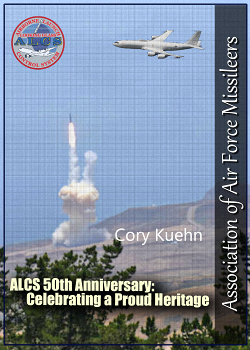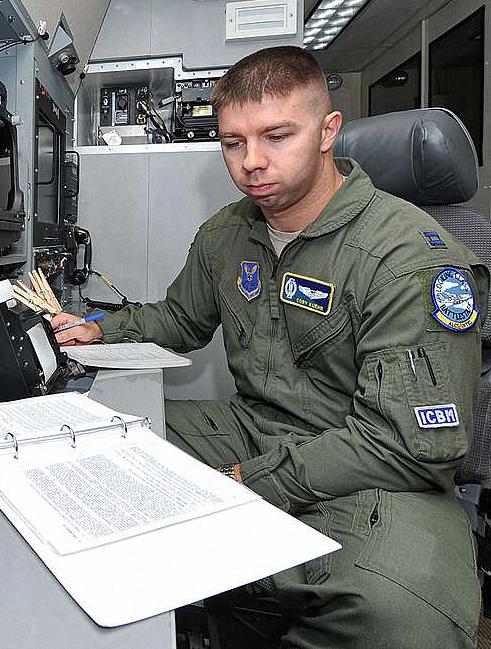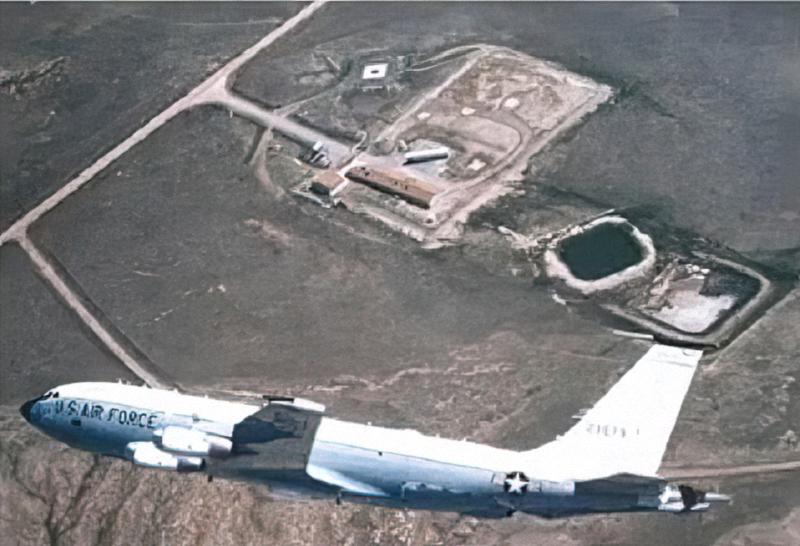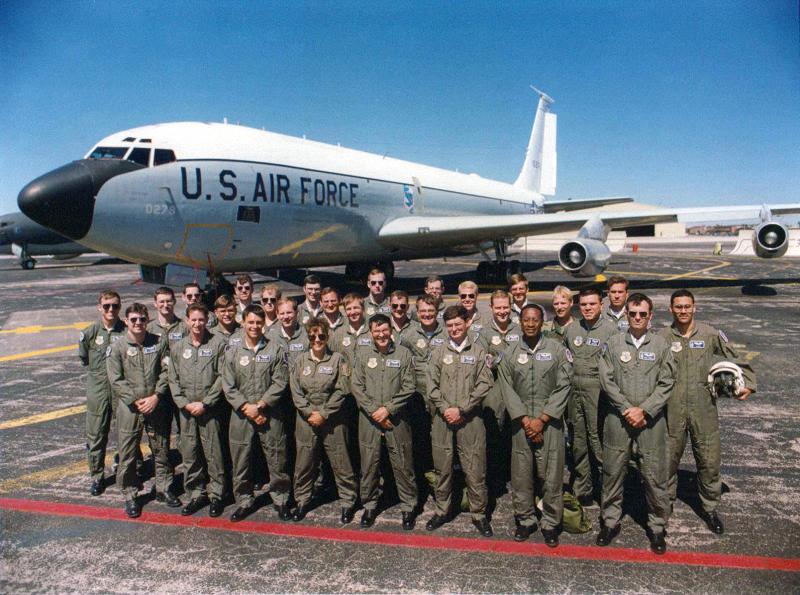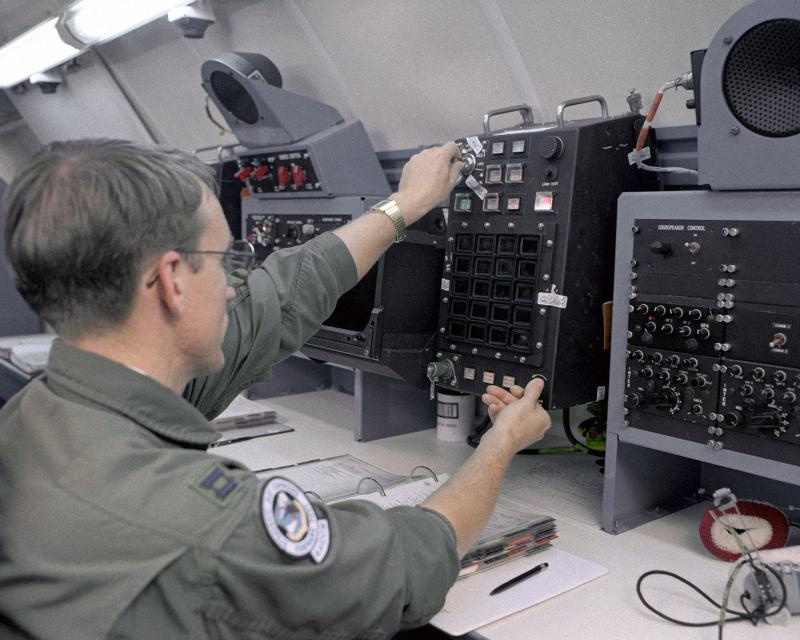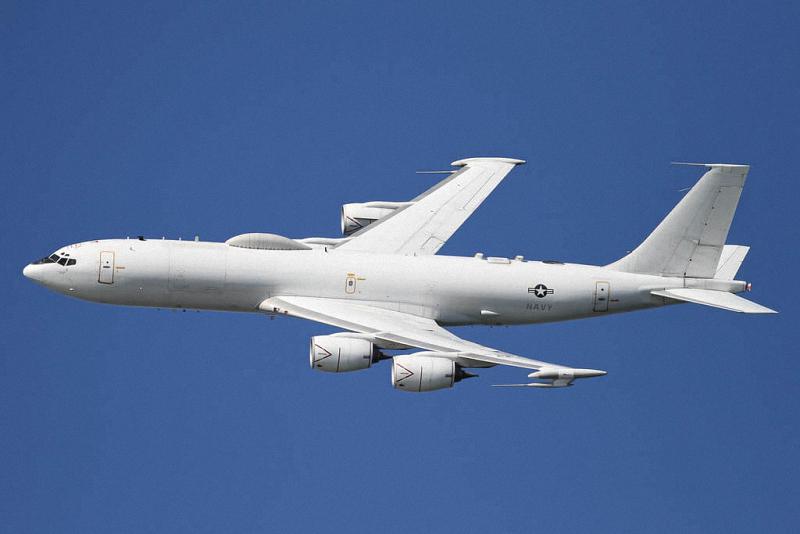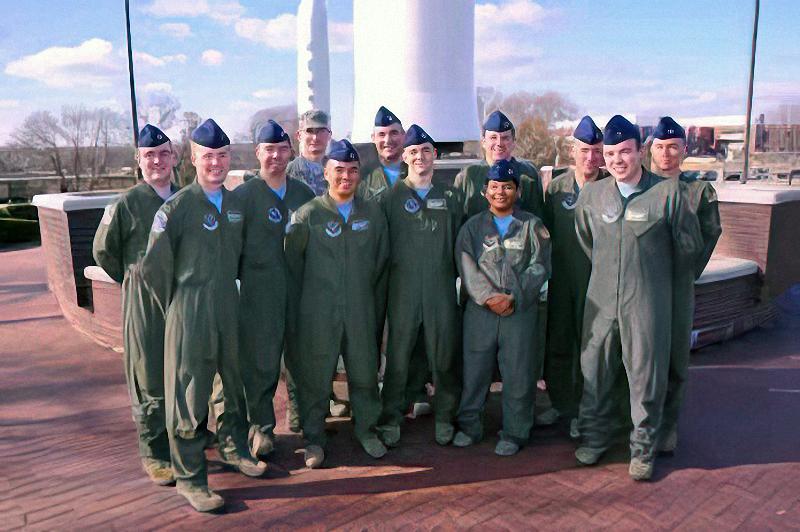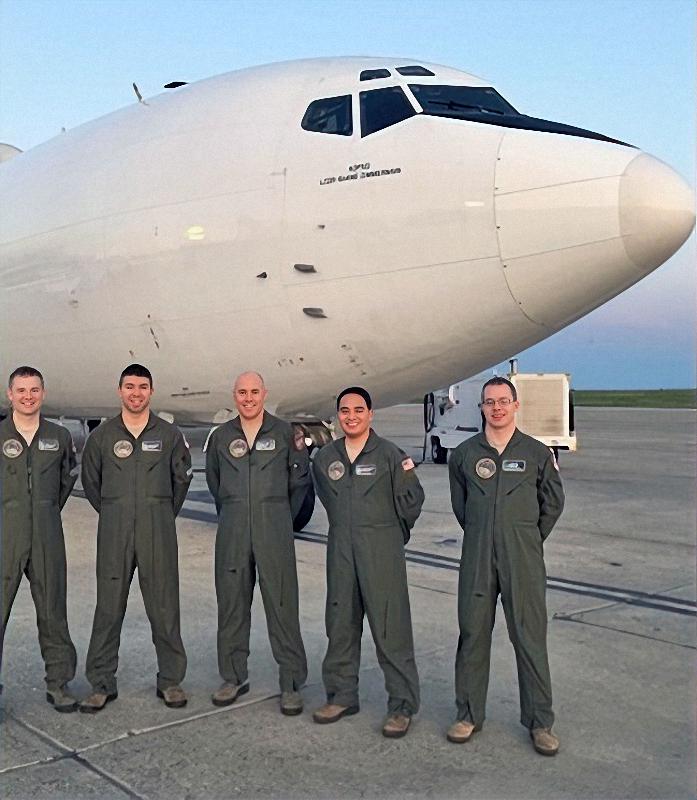|
|
|
|
|
Cory Kuehn
© «AAFM», March, 2017.
Our address: en@rvsn.info |
|
See also:
The article appeared in the March 2017 AAFM issue. Autor – Major Cory Kuehn. Current Position: ICBM Force Employment Planner Missile Assignments: 2008-2013 - 10th Missile Squadron (MS), 341st Operations Support Squadron (OSS), and 341st Operations Group evaluations shop, Malmstom AFB. MT include instructor, evaluator, Flight Commander, Emergency War Orders (EWO) Planner, and EWO Plans section chief. 2013-2017 - 625th Strategic Operations Squadron, Offutt AFB, NE, flying on USSTRATCOM’s “Looking Glass” Airborne Command Post and operating the Airborne Launch Control System (ALCS), servomg in multiple positions in the squadron and USSTRATCOM battle staff to include ALCS officer, intelligence officer, nuclear strike planner, instructor, evaluator, and flight commander. 2017-2021 - Assistant Director of Operations, 740 MS, amd 91st Missile Wing, as the Director of Inspections and then as the Wing Inspector General, Minot AFB, ND. April of 2021 - present - USSTRATCOM’s Nuclear Mission Planning Division, also known as the “Air Room.” From: AAFM, June 2021 ALCS 50th Anniversary: Celebrating a Proud Heritage «AAFM», March, 2017. Newsletter of «Association of Air Force Missileers» .
As the Air Force celebrates its 70th Anniversary this year, America’s airborne missileers will also be celebrating another milestone. The year 2017 marks the 50th Anniversary for the Airborne Launch Control System (ALCS). Since 1967, a relatively small cadre of elite airborne missileers have stood alert, providing the US a survivable intercontinental ballistic missile (ICBM) launch capability in the event the missileers in underground Launch Control Centers (LCC) were unable to do so. Just like a groundbased «Minuteman» IC3 The ALCS has a very dynamic history. It has flown onboard EC-135A, EC-135C, EC-135G, EC-135L, E-4B, and E-6B aircraft. Over the years, airborne missileers have had the capability through ALCS to remotely control «Minuteman» -I, -II, -III, and Peacekeeper ICBMs by transmitting various Preparatory Launch Commands, Enable Commands, Launch Commands, and Inhibit Commands from the air to «Minuteman» and Peacekeeper ICBMs on the ground. With the Peacekeeper ICBM, ALCS also had the capability to remotely retarget missiles and perform various other Launch Facility status and maintenance commands. Although there were several modifications over the years, the ALCS equipment essentially remained the same from its original inception in the mid-1960s to the early 1990s. However, prior to the Peacekeeper ICBM coming on alert in the mid-1980s, the new Common ALCS (CALCS) equipment began to replace the legacy ALCS equipment. Today, the CALCS equipment is the only ALCS equipment that is still operational, although it is no longer called the Common ALCS - it is just called ALCS. ALCS Inception In 1962, when the «Minuteman» ICBM was first placed on alert, the Soviet Union did not have the number of weapons, accuracy, nor significant nuclear yield to completely destroy the «Minuteman» ICBM force during an attack. However, Strategic Air Command (SAC) planners knew it was only a matter of time before the Soviets could have such capability. Early on, the Air Force experimented with using trains to make the «Minuteman» ICBMs mobile, and therefore more survivable. However, the Air Force decided to scrap the mobile Minuteman ICBM concept and emplace Minuteman in 1000 missile silos along with their 100 associated LCCs. Each facility was spread out several miles apart from each other so that the Soviets could not destroy multiple sites with just one nuclear warhead. Starting in the mid-1960s, the Soviets began to gain parity with the US and now had the potential capability to target and successfully attack the Minuteman force with an increased number of ICBMs that had greater yields and accuracy than were previously available. Studying the problem even more, SAC realized that in order to prevent the US from launching all 1000 Minuteman ICBMs, the Soviets did not have to target all 1000 Minuteman missile silos. The Soviets only needed to launch a disarming decapitation strike against the 100 Minuteman LCCs - the command and control sites - in order to prevent the launch of all Minuteman ICBMs. Even though the Minuteman ICBMs would have been left unscathed in their missile silos following an LCC decapitation strike, the Minuteman missiles could not be launched without a command and control capability. In other words, the Soviets only needed 100 warheads to fully eliminate command and control of the Minuteman ICBMs. Even if the Soviets chose to expend two to three warheads per LCC for assured damage expectancy, the Soviets would only have had to expend up to 300 warheads to disable the Minuteman ICBM force - far less than the total number of Minuteman silos. The Soviets could have then used the remaining warheads to strike other targets they chose.
Faced with only a few Minuteman LCC targets, the Soviets could have concluded that the odds of being successful in a Minuteman LCC decapitation strike were higher with less risk than it would have been having to face the almost insurmountable task of successfully attacking and destroying 1000 Minuteman silos and 100 Minuteman LCCs to ensure Minuteman was disabled. This theory motivated SAC to design a survivable means to launch Minuteman, even if all the ground-based command and control sites were destroyed.
Born out of an original concept to have an airborne launch capability from SAC’s Looking Glass aircraft to launch the Emergency Rocket Communication System (ERCS), SAC modified this plan to launch the entire Minuteman force from the air as well. The ERCS was a UHF (ultrahigh frequency) communications package placed on top of a Minuteman II in place of its nuclear warhead. Crews could record an Emergency Action Message (EAM) into the ERCS and launch the missile on a lofted trajectory broadcasting the recorded EAM below to any available strategic forces. Placed on a modified EC-135 command post aircraft and thoroughly tested, the ALCS demonstrated its capability on 17 April 1967 by launching an ERCS configured Minuteman II out of Vandenberg AFB, CA. This first test launch using the ALCS and ERCS shows the original roots of ALCS. However, all Minuteman ICBM sites were modified and built to have the capability to receive commands from ALCS. After successfully demonstrating the ALCS could launch a Minuteman ICBM from the air, ALCS achieved Initial Operational Capability (IOC) on 31 May 1967. From that point on, airborne missileers stood alert with ALCScapable EC-135 aircraft for several decades. Over the years, ALCS operations were adapted in order to ensure the most effective use of this survivable ICBM launch capability. With ALCS now standing alert around-the-clock, the Soviets could no longer successfully launch a Minuteman LCC decapitation strike. Even if the Soviets attempted to do so, EC-135s equipped with the ALCS could fly overhead and launch the remaining Minuteman ICBMs in retaliation. Now that ALCS was on alert, this complicated Soviet war planning by forcing the Soviets to not only target the 100 LCCs, but also the 1000 silos with more than one warhead in order to guarantee destruction. This would have required upwards of 3000 warheads to complete such an attack. The odds of being successful in such an attack on the Minuteman ICBM force would have been extremely low. What is more, the Soviets would have been faced with attacking the remainder of the US nuclear triad, which would have made the odds even lower. Therefore, the mission of ALCS and the nuclear triad was to deter the Soviets from launching any attack in the first place. This deterrence mission continues to this day. SAC Operations In the late 1960s and early 1970s, ALCS crews belonged to the 44th Strategic Missile Wing (SMW) at Ellsworth AFB, SD, and 91st SMW at Minot AFB, ND. ALCS equipment was installed on various EC-135 variants to include the EC-135A, EC-135C, EC-135G, and for a short while on the EC-135L. Starting in the mid-1970s, SAC command and control aircraft units were reorganized - establishing new units who operated ALCS-capable aircraft. These units included the 2nd Airborne Command and Control Squadron (ACCS) operating EC-135C aircraft out of Offutt AFB, NE, and the 4th ACCS operating EC-135A, EC-135C, and EC-135G aircraft out of Ellsworth. All three variants of these EC-135A/C/G aircraft had ALCS equipment installed onboard.
The 4 ACCS was the workhorse of ALCS operations. Three dedicated Airborne Launch Control Centers (ALCC) (pronounced “Al-see”), designated ALCC No. 1, ALCC No. 2, and ALCC No. 3 were on ground alert around-the-clock providing ALCS coverage for five of the six Minuteman ICBM Wings. These dedicated ALCCs were mostly EC-135A aircraft but sometimes were EC-135C or EC-135G aircraft, depending on availability. ALCC No. 1 was on ground alert at Ellsworth and during a wartime scenario, its role would have been to take off and orbit between the Minuteman Wings at Ellsworth and F.E. Warren AFB, WY, providing ALCS assistance if needed. ALCCs No. 2 and No. 3 were routinely on forward deployed ground alert at Minot. During a wartime scenario, ALCC No. 3’s role would have been to take off and orbit between the Minuteman ICBM Wings at Minot and Grand Forks AFB, ND, providing ALCS assistance if needed. ALCC No. 2’s dedicated role was to take off and orbit near the Minuteman ICBM Wing at Malmstrom AFB, MT, providing ALCS assistance if needed. The 4th ACCS also maintained an EC-135C or EC-135G on ground alert at Ellsworth as the West Auxiliary Airborne Command Post (WESTAUXCP) 0 a backup to SAC’s Looking Glass Airborne Command Post (ABNCP), as well as a radio relay link between the Looking Glass and ALCCs when airborne. Although equipped with ALCS, the WESTAUXCP did not have a dedicated Minuteman ICBM wing to provide ALCS assistance to.
The 2 ACCS was another major player in ALCS operations. The primary mission of the 2nd ACCS was to fly the SAC ABNCP Looking Glass aircraft in continuous airborne operations. However, due to its close proximity in orbiting over the central US, the airborne Looking Glass provided ALCS coverage for the Minuteman Wing located at Whiteman AFB, MO. Not only did Whiteman have Minuteman II ICBMs, but it also had ERCS configured Minuteman missiles on alert. The 2 ACCS also had an additional EC-135C on ground alert at Offutt as the EASTAUXCP, providing backup to the airborne Looking Glass, radio relay capability, and a means for the Commander in Chief of SAC to escape an enemy nuclear attack. Although the EASTAUXCP was ALCS capable, it did not have a dedicated ALCS mission. For a short time in the early 1980s, one E-4B National Emergency Airborne Command Post (NEACP) also had ALCS equipment installed onboard during a test proofof-concept program. Originally, SAC planned for a whole fleet of E-4Bs to replace all of the existing EC-135 Looking Glass aircraft in a program known as the Advanced ABNCP. During the test trial, an E-4B, with a full SAC battlestaff and ALCS crew onboard, periodically flew Looking Glass missions out of Offutt in order to ascertain the feasibility of replacing the EC-135 fleet. In the end however, too many resources were needed and it was deemed too expensive to have the E-4B replace the EC-135. The ALCS equipment was subsequently removed from the E-4B and it continued the NEACP mission while the various EC-135s continued to perform the ABNCP and ALCC missions. Needless to say, ALCS operations during the Cold War were the heyday for airborne missileers. Around-theclock, there were three dedicated ALCCs on ground alert, one ALCS capable Looking Glass SAC ABNCP airborne at all times, and at least two ALCS-capable Auxiliary ABNCPs on ground alert. Airborne missileers, along with all other Cold Warriors kept the peace for several decades. Post-Cold War Era Operations With the collapse of the Warsaw Pact and Soviet Union which led to the subsequent end of the Cold War, several events for ALCS unfolded. First, the 4 ACCS was deactivated along with the retirement of most of the EC-135 aircraft in the Air Force’s inventory. Looking Glass continuous airborne operations ceased, SAC was disbanded, and the 2 ACCS was redesignated as the 7 ACCS. Even though times had changed and many were eager to cash in on what many called the “Peace Dividend” of the post-Cold War era, there were others that argued against these changes. In the end, it was impossible to stop the momentum of world events. However, through all the turmoil, airborne missileers operating ALCS remained on alert and vigilant, just as they always had, with the SAC and the newly formed US Strategic Command (USSTRATCOM) EC-135C ABNCPs. The Looking Glass alert posture was now a mix of both airborne and ground alert operations. Another big change to ALCS operations occurred on 1 October 1998. On this day, the Air Force’s EC-135Cs ceased to perform USSTRATCOM Looking Glass operations and was subsequently retired. The Navy’s E-6B Mercury took over USSTRATCOM’s Looking Glass mission and associated ALCS mission. Originally, the E-6A was built to perform the Take Charge And Move Out (TACAMO) mission of relaying Emergency Action Messages to Navy Ballistic Missile Submarines in the Atlantic and Pacific oceans. However, when it was decided to retire the remainder of the Air Force’s EC-135C fleet, the E-6A was extensively modified. A battlestaff compartment was added, additional communications equipment was installed, and ALCS equipment was installed. Due to these extensive modifications, this new variant of the Mercury was redesignated from the E-6A to the E-6B. Today, whenever a USSTRATCOM battlestaff and ALCS crew are onboard, the E-6B is known as the USSTRATCOM ABNCP.
ALCS Operations Today Today, at least one USSTRATCOM ABNCP is on alert around-the-clock. It is postured with a full USSTRATCOM battlestaff and ALCS crew onboard to perform the Looking Glass mission in the event the USSTRATCOM Global Operations Center (GOC) is incapacitated. The aircraft can takeoff quickly to avoid any threat. The ALCS crew onboard still provides a survivable launch capability for the Air Force’s Minuteman III ICBMs located at the three remaining missile wings located at Malmstrom, Minot and Warren. Just like its original inception, ALCS on alert today provides an adversary with an insurmountable task of trying to destroy the Minuteman ICBM force. Even if the ground Launch Control Centers are destroyed, the USSTRATCOM ABNCP can fly overhead and the airborne missileers onboard can launch the remaining Minuteman III ICBMs. Although the ALCS resides on a Navy aircraft, the ALCS equipment is owned and operated by Air Force Global Strike Command (AFGSC). The MCCC-A is always a second or third tour assignment missileer and is from the 625th Strategic Operations Squadron (STOS) located at Offutt. The DMCCC-A is a joint USSTRATCOM position. Both ALCS crewmembers go through initial and monthly recurring ALCS training provided by the 625 STOS. As airborne missileers continue to pull alert on the USSTRATCOM ABNCP and operate the ALCS today, they look back and remember the proud heritage that previous generations of airborne missileers have built over the last 50 years. They continue to enhance deterrence and provide a survivable Minuteman ICBM launch capability. As the Air Force moves ahead with the Ground Based Strategic Deterrent (GBSD) and associated ALCS-Replacement to replace the current Minuteman III ICBM force, airborne missileers look forward to continuing the proud ALCS legacy well into the future.
|
|||||||||||||||||
